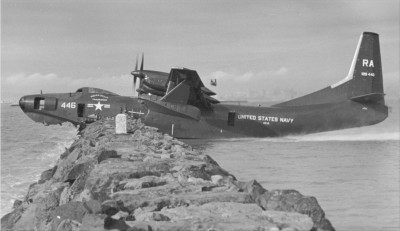|
The following is an excerpt from Homer Ragsdale ( a Lt CDR in 1958), wrote on 14 April 1958 in response to a gentleman requesting information on a crash landing he had in a R3Y-1 BUNO 128446.
The “Indian Ocean Tradewind”, an R3Y-1, departed Keehi Lagoon, Honolulu, Hawaii, at 0056 (Honolulu time), 24 January 1958, destination, Naval Air Station, Alameda, California, on board was 16,000 lbs of cargo. Estimated flight time enroute was 6 hours and 21 minutes. I was the assigned Transport Plane Commander for the flight. CDR E. B. Binkley, USN, VR-2's Alameda – Honolulu- Alameda Route Check Pilot, was assigned to the flight to administer a route check flight to me, also, he was assigned as the First Pilot of the flight. Transport pilots are route checked periodically to assure that certain qualifications are current. Also aboard was our Squadron Commander, Captain N. L Broyles, USN, who was returning to Alameda after an inspection of our Keehi Lagoon facilities.
At the time the propeller was lost, we were cruising at 21,000 feet, pressure altitude, the time was approximately 0520 (Honolulu time), this being about 15 minutes before sunrise twilight time at our position and altitude. The propeller come off with an explosive sound without warning and tore a large hole in the fuselage. Following the explosive sound was the explosive decompression and blackout. Power on the operating engines was reduced to facilitate flight control. With the power retarded to near flight idle we commenced to descend to 500 feet per minute to 16,000 ft. By this time, twilight was with us and a horizon was visible.
The radio operator broadcasted our distress message as soon as we got a transmitter back into operation. No personnel aboard were injured. Our next step was to survey the damage. We sustained damage to the fuselage, electrical system and flight control system. Our primary flight instruments were inoperative. We now felt that continued flight to Alameda was probable, though even with flight control difficulties. The San Francisco Bay area weather was poor, low ceilings and rain that was accompanied by south easterly winds over 20 knots. Flight was continued at 16,000 feet to the Farrallon Island radio beacon on top of all clouds. We found a break in the clouds over the bay. A descent was made in accordance with visual flight rules. On touch down numbers one and four engine propellers were positioned in the reverse thrust position to shorten the landing, however, due to the in-flight damage, the number one propeller did not reverse, this caused the aircraft to swerve sharply to the fight and towards the sea wall. All crew members were at their ditching station. Power was applied to the number four engine to straighten the aircraft's path down the lagoon and away from the rocks. All engines across the board were then shut down. Number one was still turning due to in-flight damage to its controls. The ship pulled to the right sharply, we attempted to pull the nose over the rocks, it just cleared, the hull contacted the break water just forward of the pilots compartment. All crew members exited the aircraft without and injuries.
Our enroute time (even though slowed down for the last 475 miles) was five hours and fifty-four minutes from the take off at Keehi Lagoon, Honolulu to San Francisco. The “Indian Ocean” had beaten the record time for any transport aircraft between Honolulu and San Francisco, this includes all military or commercial prop driven aircraft. I do not know what caused the propeller leave the aircraft.
| Attachments: |

on the rocks.jpg [ 85.85 KiB | Viewed 2228 times ]
|
|





